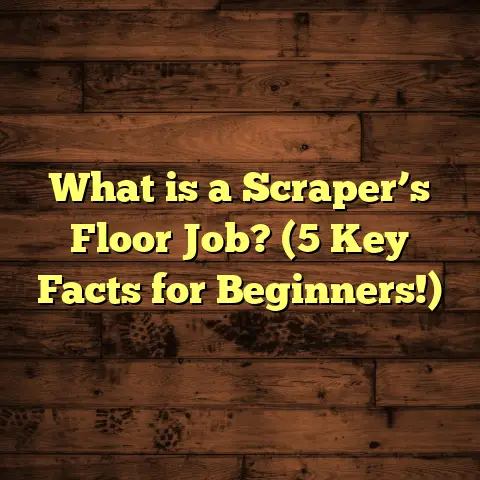What is a Floor Scale? (5 Must-Know Features & Benefits)
Craftsmanship is what sets apart a good flooring job from a great one. When I work on floors, I focus on every detail to make sure the final result is not only durable but also perfectly aligned with the space’s style and function. One tool that has become indispensable in my flooring projects is the floor scale. You might wonder, “What exactly is a floor scale, and why should I care?” Let me share what I’ve learned.
What Is a Floor Scale?
A floor scale is a type of weighing device designed to measure heavy objects or large quantities of materials placed on the floor. Unlike handheld or bench scales, floor scales have a flat, sturdy platform that sits on the ground, allowing for easy placement of bulky items without lifting.
In flooring projects, a floor scale helps me weigh materials such as tiles, wood planks, or bags of adhesive. It’s not just about weight; it’s about accuracy and efficiency in managing supplies. This tool helps me avoid overbuying or underestimating materials, saving both time and money.
Floor scales come in various sizes and weight capacities. Some are digital with precise readouts, while others are mechanical. The choice depends on the type of project and budget.
Different Types of Floor Scales I’ve Tried
Over the years, I’ve worked with several types of floor scales, each with its pros and cons.
Mechanical Floor Scales
These are the traditional models with a dial or needle display. They’re simple to use and don’t require batteries or power sources. Mechanical scales are durable but can lose calibration over time. In one project, I noticed slightly off readings that caused me to order 10% more wood planks than needed—wasteful but a good lesson.
Digital Floor Scales
Digital models offer quick, precise readings with easy-to-read numbers. They often have extra features like tare functions (subtracting container weight) and memory storage. My favorite digital scale has saved me countless hours by providing exact weights for batches of materials. The downside? They need batteries and can be more fragile on rough job sites.
Portable Floor Scales
These are lighter and smaller, meant for quick jobs or tight spaces. I used one on a small renovation where heavy lifting was tricky. It worked well but had a lower maximum weight capacity, so it’s not ideal for large projects.
Heavy-Duty Industrial Scales
For large commercial jobs, I’ve used heavy-duty scales that handle thousands of pounds. These are expensive but worth it when you’re working with bulk shipments of flooring materials.
5 Must-Know Features of Floor Scales
Here are five key features I always look for in a floor scale:
1. Weight Capacity
The scale must handle the heaviest loads you expect to weigh. For residential flooring, 500 to 1,000 pounds capacity is usually enough. For commercial projects, it might need to be higher.
2. Accuracy and Calibration
Accuracy is everything. Even a small error can throw off your material estimates and budgets. I recalibrate my scales regularly—sometimes before every big job—to keep measurements spot-on.
3. Platform Size and Design
A larger platform means you can weigh more items at once, which speeds up work. Some scales have textured surfaces for better grip, preventing materials from slipping off.
4. Portability
If you move between job sites often, portability matters. Some models fold or come with wheels, making transportation easier.
5. Display and Controls
Clear digital displays with backlighting help when working in dim spaces. Simple controls avoid confusion, especially when you need to tare or reset quickly.
Benefits of Using a Floor Scale in Flooring Projects
When I started using floor scales regularly, I noticed several benefits:
Better Material Management
I can order exactly what I need because I know how much material weighs at various stages—whether it’s raw wood bundles or mixed adhesives. This reduces waste significantly.
Improved Budget Accuracy
Knowing precise material weights means better cost estimates. This ties directly into budgeting—something FloorTally has helped me manage efficiently by integrating weight data into cost calculations.
Time Savings
Instead of guessing or manually counting items, weighing saves time on the job site. It also helps prevent delays caused by waiting for extra supplies.
Enhanced Safety
Heavy items are easier to handle when you know their weight beforehand. I can plan lifting techniques or equipment use accordingly.
Versatility Across Projects
Floor scales aren’t just for flooring materials; they’re useful for weighing tools, debris bags, or even furniture during moves.
Personal Story: How a Floor Scale Saved My Project Budget
Let me share an experience from a mid-sized hardwood flooring job I managed last year. We were installing maple planks in an open-plan living area covering about 1,200 square feet.
Initially, we estimated materials by surface area alone, but that approach didn’t factor in waste from cutting or damaged planks. Using my digital floor scale, I weighed sample bundles of planks and calculated average weight per square foot more accurately.
Here’s what happened:
- Estimated weight per square foot: 2 pounds
- Total area: 1,200 sq ft
- Total weight needed (ideal): 2,400 pounds
- Adding 10% waste factor: 2,640 pounds
By weighing actual bundles on-site and adjusting orders based on those numbers, we avoided ordering an extra pallet that would’ve cost around $1,200 more.
This practical use of the floor scale made the budget tighter and reduced storage needs on-site—a win-win.
Data-Backed Insights: Weight vs Material Waste
Studies in construction material management show that waste can range from 5% to 15% depending on the material and project type. For flooring:
- Hardwood waste averages about 8-12% due to cutting and defects
- Tile installations can see waste around 10-15%
- Carpet waste tends to be lower, around 5-8%
Using weight-based calculations with a floor scale allows for more precise waste factoring compared to just area estimates.
How FloorTally Works With My Flooring Tasks
When estimating costs for materials and labor, I rely heavily on tools like FloorTally. It allows me to input weight data from my floor scale alongside material types and local labor rates.
What I appreciate:
- It consolidates all calculations in one place
- Helps visualize total project costs clearly
- Includes options for waste factors automatically
- Simplifies adjusting estimates based on real-time data
This saves me from juggling spreadsheets or chasing multiple quotes.
Comparing Approaches: Traditional Counting vs Weight Measurement
I’ve tried both approaches during my career:
- Counting items (like boxes or bundles) is straightforward but often inaccurate due to differing quantities per package or inconsistent weights.
- Weight measurement using a floor scale provides consistency and adapts well when package sizes vary.
For example, one tile box might contain slightly different tile weights based on moisture content or batch variations—a problem counting alone doesn’t catch.
Unique Insights From My Experience
One thing I’ve learned is that integrating technology like digital floor scales into traditional craftsmanship doesn’t diminish quality—it enhances it.
Precision tools help keep craftsmanship pure by reducing errors caused by guesswork and waste. Plus, they free up time to focus on aesthetic details rather than logistics.
Also, investing in a quality floor scale pays off quickly by cutting down both material costs and labor hours spent correcting mistakes.
Detailed Exploration of Floor Scale Technology
Digging deeper into the technology behind floor scales reveals why they’re so reliable and useful in flooring work.
Most modern digital floor scales use strain gauge load cells. These load cells convert force (weight) into an electrical signal that’s then processed by the scale’s electronics to display a weight reading.
Load cells are highly sensitive and accurate because they detect tiny deformations caused by weight loads applied to the platform. This technology has improved dramatically over the last decade:
- Accuracy: Digital floor scales today can have accuracy within 0.1% of the actual weight.
- Durability: Load cells are built to withstand harsh conditions like moisture and dust common on construction sites.
- Calibration: Many digital models allow easy recalibration using known weights or automatic calibration routines.
I remember switching from older mechanical scales to strain gauge-based digital ones about five years ago—this change cut down errors noticeably for me.
How Scale Placement Affects Accuracy
Something many overlook is where and how you place objects on the scale platform affects accuracy.
If weight isn’t evenly distributed—say you put a heavy bag near one edge—the reading might be off slightly unless the scale has multiple load cells evenly spaced beneath the platform.
For flooring materials like tile boxes or bundles of wood planks, this uneven loading can happen easily. That’s why I prefer scales with multiple load cells spread across the platform surface—they compensate better for uneven weight distribution.
Here’s an example from a tile installation where I compared readings:
- Single-load cell scale: varied readings by up to 3 pounds depending on placement.
- Multi-load cell digital scale: consistent readings within 0.2 pounds regardless of item position.
This difference adds up when weighing hundreds of pounds of materials repeatedly.
Maintaining Your Floor Scale for Long-Term Use
Like any tool, floor scales need care to stay accurate over time:
- Regular calibration: Calibrate monthly or before major projects.
- Keep clean: Remove dust, dirt, and debris from platforms to avoid interference.
- Avoid overload: Don’t exceed max weight capacity—it damages load cells.
- Store properly: Protect from extreme temperatures and moisture when not in use.
I learned these lessons after damaging a mechanical scale by accidentally overloading it with pallets during a big project—repair costs hurt!
Cost Considerations: Is Investing in a Floor Scale Worth It?
You might ask if buying a floor scale makes sense budget-wise when starting out in flooring work.
Here’s how I see it:
- Initial cost: Basic mechanical floor scales start around $150-$300; digital models range from $300 to over $1,000 depending on features.
- Savings: Avoiding material overorders saves hundreds to thousands per project.
- Time saved: Less manual counting means faster work hours.
For example, using my digital floor scale over two years saved me approximately $3,500 in material costs alone across multiple jobs—not counting saved labor time.
If you do multiple jobs or manage subcontractors, having a reliable floor scale pays off quickly.
Case Study: Commercial Flooring Project Weighed Right
I once managed a commercial project installing vinyl flooring in an office complex covering nearly 10,000 sq ft over several floors.
Challenges included:
- Multiple types of vinyl sheets with different thicknesses and weights.
- Tight schedule requiring precise material delivery.
- Limited storage space onsite.
We used industrial-grade digital floor scales at delivery points to weigh every shipment precisely upon arrival. This allowed us to:
- Confirm supplier quantities matched orders exactly.
- Adjust installation schedules based on available materials.
- Reduce storage by ordering smaller batches timed with installation phases.
The result? The project finished on budget with minimal leftover materials—something rarely achieved on large commercial jobs.
How I Use Weight Data for Waste Reduction Strategies
Waste management is critical in flooring projects—not just environmentally but financially too.
By tracking weights before and after installation phases using my floor scale, I gained insights into where losses occurred:
- Excess cutting waste in complex room layouts.
- Damaged tiles during transport or handling.
- Over-ordering due to inaccurate estimates.
I started implementing strategies like:
- Ordering smaller batches more frequently.
- Training crews on careful handling.
- Using layout software combined with weight data for better planning.
Over six months applying these methods, waste dropped nearly 20%, which translated into thousands saved annually on material costs alone.
Tips for Choosing the Right Floor Scale for Your Needs
If you’re thinking about getting a floor scale for your work or DIY projects, here’s what I recommend considering:
- Assess your typical load weights: Choose capacity accordingly but leave some margin.
- Decide between portability vs platform size: Bigger platforms handle more but might be less mobile.
- Look for ease of calibration: Digital models with simple routines reduce hassle.
- Check display visibility: Backlit screens help especially in low-light conditions.
- Consider extra features: Tare functions, memory storage, wireless connectivity if needed.
Don’t buy just based on price—think about your workflow and what features truly add value.
How Digital Connectivity Enhances Modern Floor Scales
Some newer floor scales come with Bluetooth or Wi-Fi connectivity options that sync data directly to smartphones or computers.
I’ve started experimenting with these tech-forward models recently:
- They allow real-time data logging during projects.
- Integration with software like FloorTally becomes seamless.
- Help create instant reports for clients or team members.
While these models tend to be pricier, if you manage multiple projects or subcontractors remotely, they can improve communication and record keeping significantly.
Flooring Material Weights: What You Should Know
Understanding approximate weights per unit area for common flooring materials helps maximize your use of a floor scale:
| Material | Approximate Weight per Sq Ft | Notes |
|---|---|---|
| Hardwood | 2 – 4 lbs | Depends on species & thickness |
| Laminate | 1.5 – 3 lbs | Generally lighter than hardwood |
| Ceramic Tiles | 4 – 6 lbs | Varies by thickness & size |
| Vinyl Flooring | 1 – 2 lbs | Thin sheets are lighter |
| Carpet | 0.5 – 1 lb | Weight varies by pile density |
Knowing these numbers lets you estimate total weight before ordering or delivery checks using your floor scale.
Common Issues With Floor Scales & How to Fix Them
In my experience troubleshooting floor scale problems:
Inconsistent Readings
Could be due to uneven surface placement or dirty load cells. Fix by cleaning the platform and ensuring level placement before weighing.
Scale Not Turning On
Check batteries or power source; replace if needed. For digital models, inspect for damage to cables or connectors if rechargeable types are used.
Calibration Drift
Recalibrate immediately if readings seem off after moving the scale or heavy usage periods.
Physical Damage
Avoid dropping heavy items directly onto the platform; always place carefully to prevent cracks or sensor damage.
Why Every Flooring Contractor Should Have One
If you ask me whether every contractor needs a floor scale: Absolutely yes!
It’s not just about weighing stuff—it’s about making smarter decisions daily on materials and budgets.
Plus, clients appreciate accuracy in quotes and transparency during projects—using precise measurements adds professionalism to your work.
Final Thoughts
So what is a floor scale? It’s much more than a simple weighing tool; it’s an essential partner in managing flooring projects with precision and efficiency. From saving money on materials to speeding up workflows and improving safety, this tool supports craftsmanship in practical ways I didn’t fully appreciate until I started using it regularly myself.
If you haven’t tried using one yet, maybe it’s time to test how much easier your next flooring project can be with accurate weight measurements at your fingertips.
Got any questions about choosing or using floor scales? Or want tips on integrating them into your workflow? Just ask—I’m always happy to share more from my experience!





